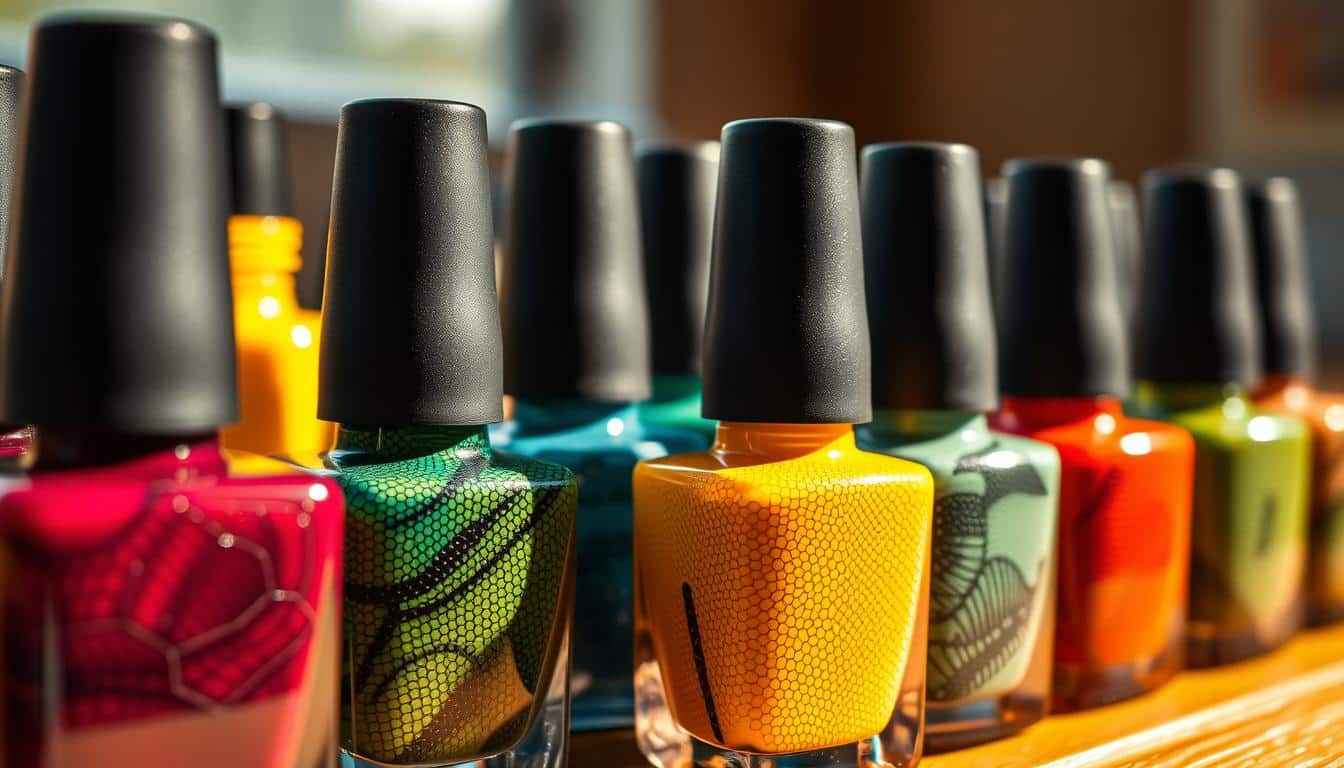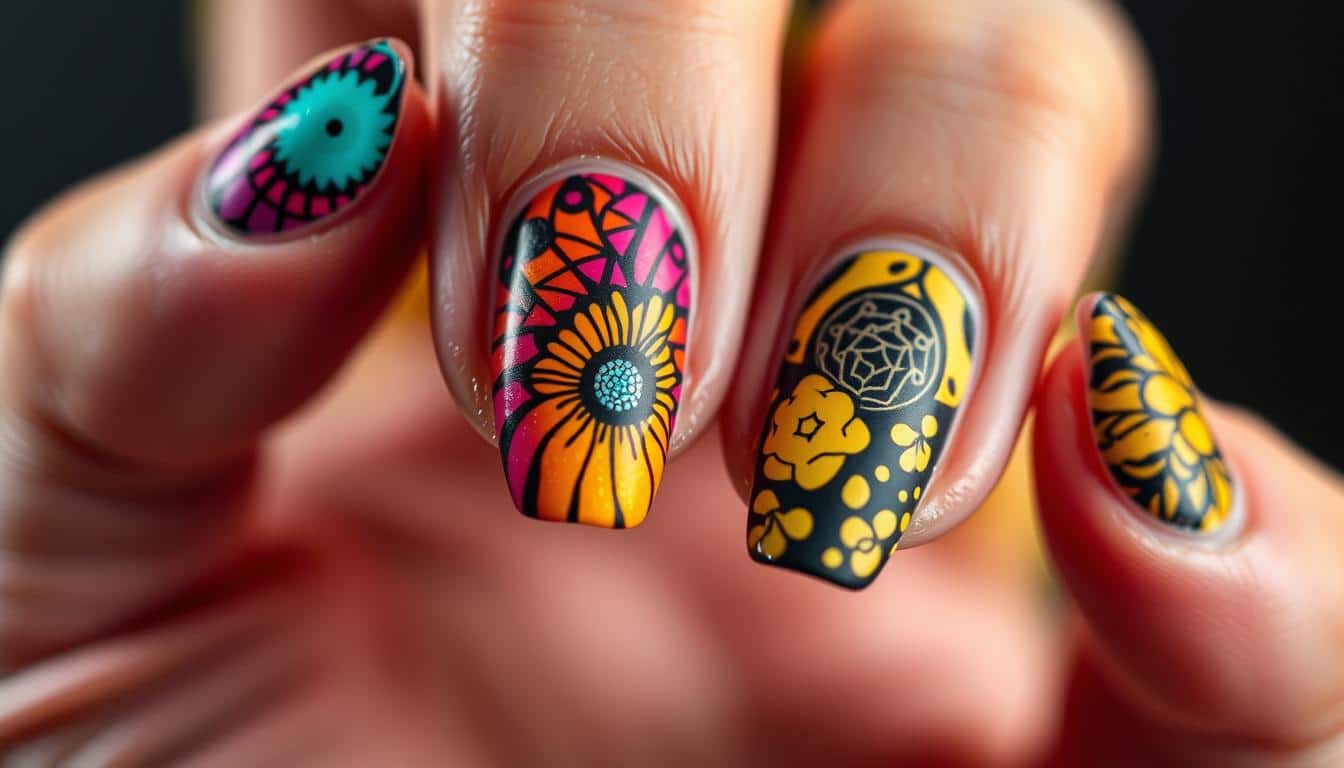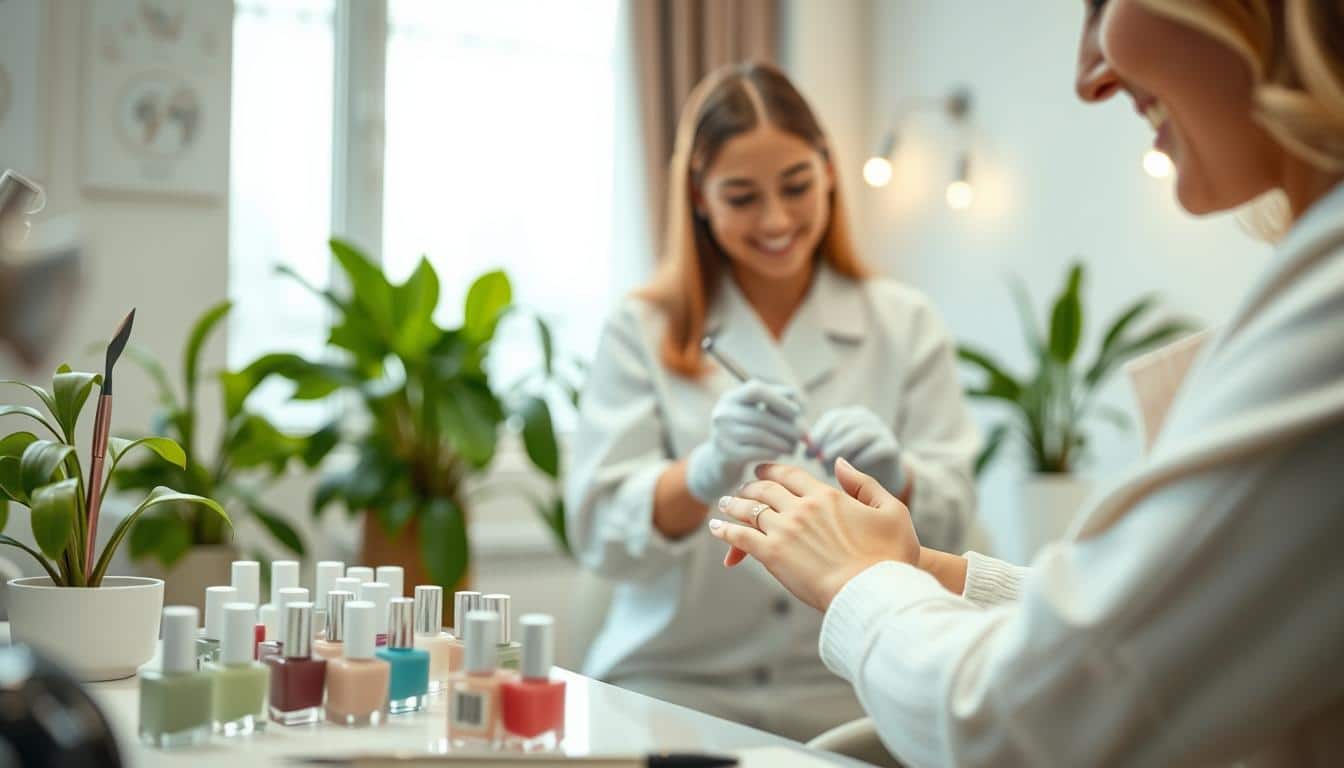Anúncios
As a pet owner, your reptiles’ health and safety are very important. You might worry if your nail polish could harm them. This article talks about the dangers of nail polish and its harmful ingredients to your scaly pets. We’ll share safe options, so you can take care of your reptiles wisely.
The Dangers of Nail Polish Around Pets
Nail polish is liked by many people but can be risky for pets. Common nail polish ingredients have toxic chemicals. These can make animals very sick. Owners, especially those with reptiles, need to understand these risks.
Understanding Toxic Ingredients
Nail polish has several harmful chemicals. These can hurt not just people but animals too. Even products that say they are “natural” or “toxin-free” might still have harmful parts. Knowing what these ingredients are is key to keeping your pets safe.
Common Nail Polish Chemicals
- Dibutyl phthalate
- Toluene
- Formaldehyde
Ingredients in nail polish can be bad for pets’ health. Toxins can still harm pets even if the polish has dried. Pets might lick it off their owner’s skin. Knowing these dangers helps pet owners pick safer options. This makes for a safer place for all pets.
Can You Wear Nail Polish Around Reptiles?
Wearing nail polish around reptiles makes us question their health and safety. Vets say the risk from dry nail polish is usually low. But, the safety of nail polish also depends on a few things, like if it’s fully dry or has harmful ingredients.
Veterinary Perspectives on Nail Polish Safety
Vets suggest being careful with nail polish around pets, including reptiles. Dr. Justine Lee talks about keeping a safe space for these animals. She says there’s a small risk from nail polish that’s completely dried. However, it’s always best to be careful to keep reptiles safe, especially from polish with dangerous ingredients.
Potential Risks for Reptiles
Reptiles are very sensitive to their environment. This means pet owners need to think about nail polish risks. Reptiles could get hurt from nail polish that’s not dry. Being aware of vet advice on nail polish can help prevent health issues for these animals.
Signs of Nail Polish Toxicity in Reptiles
Looking after reptiles means you need to watch their health closely. Knowing the signs of toxicity is key for pet owners. Watch for signs like being tired, not eating, having trouble breathing, or acting strange. Spotting these early helps you deal with any problems from toxic things like nail polish quickly.
What to Look For
Watch for these signs that suggest your reptile might be reacting badly to something toxic:
- Lethargy
- Loss of appetite
- Labored or abnormal breathing
- Changes in normal behavior, such as hiding more than usual
Immediate Actions to Take
If you see any signs of toxicity, you need to act fast. Here are the first steps to take:
- Remove the source of exposure immediately.
- Contact a veterinarian for advice on what to do next.
- Provide supportive care as recommended, making sure they’re calm and safe.
Alternatives to Traditional Nail Polish
Using non-toxic nail polish is smart when you have reptiles around. It lets you keep your nails pretty without risking your pet’s health. Many kid-friendly products work well too.
Safe Non-Toxic Options
You can find non-toxic nail polish in specialty stores and kid sections. Top brands make safe polish that’s kind to reptiles and people. These products let you enjoy bright colors without fear of harming your pets or children.
Using Non-Toxic Kids’ Products
Kids’ products like washable markers or UV body paint are great for nails too. They’re safe, easy to remove, and usually free from bad stuff. Just make sure they’re safe for your reptile-filled home by checking the ingredients.
Identifying Your Reptile Without Nail Polish
Using nail polish isn’t a good way to tell reptiles apart. Photos are a safer and more accurate choice. By taking pictures of your pet’s distinct spots, you avoid using harmful products. Knowing their unique marks means you can recognize each reptile more easily.
Using Photographic Evidence
Take sharp, detailed photos of your reptile for better identification. Notice their color patterns and scale textures. Keeping your pictures up to date is important for recognizing them.
Understanding Unique Markings
Every reptile has its own special markings. These can be things like patterns, colors, or scars. Learning about these features helps you take better care of them. It also makes talking to pet experts easier when you need to.
Expert Opinions on Aesthetics and Reptile Safety
Experts in pet safety stress the need to put reptile well-being first. They note that nail polish looks nice but can be risky. The danger lies in the nail polish risks from toxic substances in many polishes.
Viewpoints from Pet Poison Experts
Pet poison specialists urge people to check nail product ingredients. Some polishes have chemicals harmful to reptiles. They advise carefully reading product labels before using nail polish around these animals.
The Real Risks of Exposure
Exposure’s effects might not be clear at first, experts say. Certain components may harm a reptile’s breathing or skin. Through their advice, poison experts make pet owners rethink beauty choices for their pet’s health.
Nail Polish Application Tips for Pet Owners
For pet owners who love nail polish, there’s a way to enjoy it without risking your reptile’s health. Knowing how to do your nails safely is key. You should use safer products and choose the right times to keep harmful chemicals away from your pets.
Best Practices for Nail Care
Keeping your nails pretty while making sure your pets are safe requires care. Here are the top tips for pet parents:
- Choose non-toxic nail polish alternatives that do not contain harmful ingredients.
- Establish a designated area away from reptiles for application, ensuring they are secure.
- Wash hands thoroughly before and after applying nail products to avoid transferring chemicals.
- Store all nail care products out of reach of pets.
Timing Your Manicure with Reptile Care
Planning when to do your nails is important for your reptile’s health. Keep these points in mind:
- Allow ample time for the polish to dry completely before reintroducing reptiles to the area.
- Plan manicures during your pet’s mealtime or when they are in their habitat, which helps minimize interaction.
- Monitor your reptiles for any signs of distress when they are near recently polished nails.
Behavioral Impacts of Wearing Nail Polish
Reptiles have a keen sense of smell. They react to new smells in their space. Nail polish brings unknown scents that can change how they act, possibly stressing them out.
How Reptiles Respond to Scent
Reptiles might act curious or avoid the smell of nail polish. Their behaviors can change. These behaviors include:
- Increased pacing or movement in their enclosure
- Refusal to eat or engage with food
- Hiding or seeking shelters more frequently
Potential Stress for Creatures
The scent of nail polish can make reptiles stressed. This stress can make them act differently, such as:
- Erratic movements or attempts to escape
- Changes in skin color or posture
- Vocalizations, like hissing or growling, which are signs of distress
It’s important to know how scents affect reptiles. If we notice they are stressed, we can make their home better. We should try to keep harmful smells away from them.
Ensuring a Safe Home Environment for Reptiles
Keeping a safe home for reptiles means more than avoiding nail polish. Many usual things at home can be dangerous to these pets. Knowing what could hurt them helps make a safe place for them to live.
Household Dangers Beyond Nail Polish
Homeowners need to watch out for products that reptiles shouldn’t be around, like:
- Cleaning agents containing harsh chemicals
- Some houseplants that are toxic when eaten
- Open beauty items and personal care products
Finding these dangers can greatly increase your reptile’s safety. Knowing about safer options helps protect these delicate animals.
Creating a Pet-Friendly Space
To make a space where your reptile can thrive, think about what they need. Start by getting rid of things that could be bad for them. For a safer home:
- Use cleaning products that aren’t toxic
- Stay away from plants that could hurt them
- Keep food and beauty products stored away safely
Following these guidelines will help make a secure place where your reptiles can be healthy and joyous.

Conclusion
The beauty of colorful nail polish can come with worries about its safety for reptile care. It’s important for pet owners to know that the health risks for these gentle animals can be greater than the joy of having pretty nails. Learning about the harmful ingredients in nail polish is key to taking good care of pets.
Pet owners must make sure their reptiles are safe. They should look for safer options that don’t have dangerous chemicals. By choosing wisely, they can keep both beauty and safety in their homes.
Being careful and well-informed is vital for the health of reptiles. Owners can provide a safe place for their pets while still enjoying their own style. This way, everyone, including the pets, can live happily and healthily.



